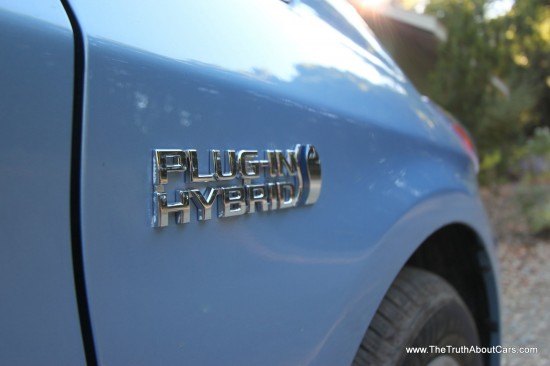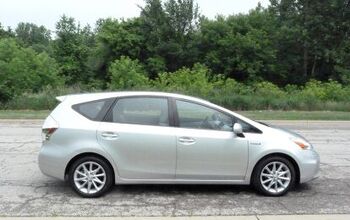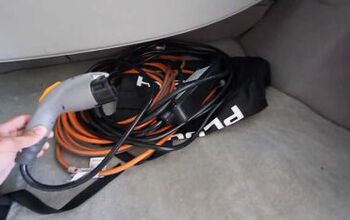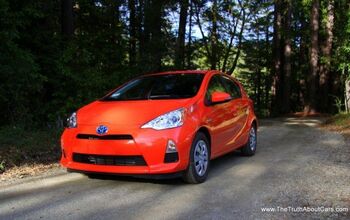Review: 2012 Toyota Prius Plug-In Hybrid

Public beta tests are common in the computer world where a group of fanatics pound your beta to death and help you find the problems. In the automotive world this activity is not only rare, it runs contrary to the cash spent on dressing future cars in swirly vinyl. The Prius plug-in is different. Toyota built 600 demonstrators and sent them to large corporations, Zipcar fleets and, of course the press. Even TTAC was allowed to drive one for a week. What does that have to do with the final product? And how does it stack up against the Volt, Plug-in Fusion and the 2013 Accord Plug-in? Let’s find out.
There is little to distinguish the Plug-in from the “normal” Prius save the charging door on the right rear quarter panel and (if you’re in California) and the green HOV access stickers. The lack of distinctiveness is either a benefit or a drawback depending on how loud you want to proclaim your “greenness.” The lack of differentiation made financial sense for Toyota as the Prius is rumored to be redesigned for the 2015 model year. Compared to the beta car, Toyota relocated the charging port to the rear meaning I had to back into parking spots to use some public charging stations. Ever wondered why the LEAF’s port is in the nose? Now you know.
Because the Prius’ chassis was designed for a large battery, no changes to the passenger compartment were required. The cargo area is a different story. The regular Prius operates in EV mode up to 42MPH with a range of two miles if you are extremely gentle on the throttle. The plug-in’s range is 11-15 miles thanks to a bigger battery. Toyota achieved the capacity increase by using denser lithium-ion batteries (instead of nickel hydride) and converting the spare tire area into a battery compartment. The result is an increase in capacity from 1.3kWh to 4.4kWh at the cost of the spare and the jack. The beta car used a 5.2kWh battery pack that was segmented into one 1.2kWh pack and two 2kWh packs. The reason for the change was the three pack arrangement wasn’t as efficient and the beta testers complained there was no way to regenerate power back into the dual 2kWh packs once they were exhausted.
A 3.1kWh jump doesn’t sound like much until you understand how the Prius uses the battery. To preserve the life of the battery, a regular Prius will never fully discharge or charge the battery (batteries “wear” faster when their charge state is at either extreme), reducing the usable capacity to around 0.6kWh. For plug-in duty, Toyota expanded this usable capacity to somewhere around 4.2kWh. In comparison, the Volt’s usable capacity is around 12.9kWh and the 2013 Accord plug-in is 6kWh.
Under the hood you will find the same 1.8L, 98HP engine and “power splitting device” as a regular Prius. The engine and electric motors even put out the same combined 134HP. I know what Prius owners are thinking: Hang on, if it’s the same drivetrain, why is my Prius limited to 42MPH in EV mode? You won’t find the answer under the hood, it’s the battery and the software. The Prius’ traction motor (MG2) is the motor connected to the wheels and depending on how you look at the way the transaxle works (great link for tech-heads at eahart.com), MG2 is doing most of the work when you’re moving forward. That’s why MG2 is an 81HP motor. The “problem” with the regular Prius is the discharge rate. The 1.4kWh NiMH battery can deliver only 36HP peak and 27HP of continuous power. The plug-in’s larger batter on the other hand is capable of delivering 51HP of continuous power. If your power demands exceed the neighborhood of 51HP, then the engine turns on to make up the difference up to 134. This new battery pack has another benefit: greater regeneration capacity. On my daily commute I go over a 2,200ft mountain pass, a regular Prius’ battery would be full around 1,700ft. Because the plug-in was able to regenerate all the way down, I gained 7 miles of EV range to make up for the extra gas it took to get me up the hill in the first place.
The Prius isn’t an EV, and it’s not trying to be a “Toyota Volt” either. Yet, it’s more than just a CARB compliance car as well. Unlike the Volt, Fisker, or even the new Accord Hybrid, the Prius can’t live without its engine. Even for short drives. If you floor the car, the engine comes on, and while the beta car had a slick heat-pump to heat the cabin, the production car uses engine heat like a regular Prius. Instead, the Prius plug-in is a new type of car where locomotion blends two different fuel sources trading a portion of the gasoline you pay $4.35 a gallon for in California for electricity at $0.10-$0.15 per kWh. The coming Ford plug-in hybrids operate in essentially the same way.
Let’s look at these numbers in terms of a commute. I drive 106 miles a day, and my commute involves city, highway and rural mountain roads. Starting with fuel economy without charging: the Volt averaged 33MPG, the Prius averaged 50 and the Prius plug-in averaged 52. (Credit the greater ability to regenerate for the improved figure.) With charging on both ends of my commute, the Volt averaged 40MPG, and the Prius plug-in averaged 72MPG.
According to our calculations, if your commute is under 27 miles total, or 27 miles each way with charging on either end at $0.15/kWh, the Volt is the cheaper vehicle to run. The more expensive the electricity, the better the Prius’s proposition. Even at $4.35 a gallon gasoline. My average rate at home is $0.27/kWh due to my agricultural rate which bumps the operational cost of the Volt higher than the Prius plug-in at anything over a 1-mile distance. Check your rates before you plug-in.
On the road, the plug-in behaves just like a regular Prius thanks to gaining only 150lbs. As you would expect, the low rolling resistance tires deliver moderate road noise and precious little grip. The steering is numb a bit over-boosted, body roll is average and acceleration is leisurely. Is that a problem? Not in my mind. The Prius’ mission is efficiency and not driving pleasure.
When in EV mode, exceeding 3/4 throttle will cause the engine to start, something I still think is a pity. Still, the plug-in is perfectly capable of tacking mountainous terrain in pure EV mode. At speeds above about 50MPH you have to be more gentle on the throttle in order to prevent the engine from kicking in and at 62 the engine starts no matter how ginger you are. If it’s a cold day outside and you’re using the cabin heater, the Prius’ engine will turn on immediately and run to keep the cabin warm. Unlike a regular Prius , if you are in EV mode, the engine will be essentially idling and generating a small amount of power as long as you keep your speed under 62.
Although the battery and motor are likely capable of speeds greater than 62MPH, the system’s design requires the engine to be spinning. This means that in “EV mode” above 62MPH, the EV battery provides the majority of the energy while the engine essentially idles. In this operation, we were easily getting 180 MPG while on a level freeway traveling 70MPH for 9-10 miles.
With a starting price of $32,000, or $40,285 if you prefer your hybrid fully-loaded, the Prius plug-in has a limited market in mind. You either need to want the latest in Prius tech, or be willing to pay $8,000 to use the HOV lanes for a few years. While I do believe it would be possible to eventually save money vs a regular Prius, it will take an eternity and some serious number crunching. On my commute it would take 300,000 miles for the plug-in to break even with a $24,000 Prius. If your commute is 24 miles a day, then the break even drops to 130,000 miles. But at 24 miles a day, it would take you 20 years. Still, there is that HOV lane to consider. On my route the HOV stickers would cut my daily travel by 30 minutes or 11 hours a month. How much is that worth to you? If your answer isn’t: $8,000, then click on over to our Prius C review. While the Prius plug-in may make sense for a select few, the Toyota’s beta program still succeeded in several ways. Toyota implemented some major changes to the battery systems as a result of the feedback and gained a non-stop flow of reviews in the process. If only Bentley could do the same.
Toyota provided the vehicle, insurance and fuel for this review.
Fuel economy average over 583miles: 65
Percent of time in EV mode: 20%
Performance statistics as tested:
0-30: 3.4 seconds
0-60: 10.0 seconds
¼ Mile: 17sec @ 79 MPH

More by Alex L. Dykes
Latest Car Reviews
Read moreLatest Product Reviews
Read moreRecent Comments
- Spectator Wild to me the US sent like $100B overseas for other peoples wars while we clammer over .1% of that money being used to promote EVs in our country.
- Spectator got a pic of that 27 inch screen? That sounds massive!
- MaintenanceCosts "And with ANY car, always budget for maintenance."The question is whether you have to budget a thousand bucks (or euro) a year, or a quarter of your income.
- FreedMike The NASCAR race was a dandy. That finish…
- EBFlex It’s ironic that the typical low IQ big government simps are all over this yet we’re completely silent when oil companies took massive losses during Covid. Funny how that’s fine but profits aren’t. These people have no idea how business works.





























































Comments
Join the conversation
Those sneaky marketing folks at Toyota. The image of the Prius's has shifted from being owned by woolly-headed greenies and wine snob effetes to mainstream acceptance. Decent cars being sold at decent prices and owners of Prius's won't spend much on gas or maintenance. The blandest car company on earth has made hybrids acceptable.
The Volt is a "higher concept" than the Prius. It can be a true EV car for most people, covering 35-40 miles on one charge. It is on the right path, but it is not ready to walk that path most righteously. Why? The reasons why the Prius is a better choice is because the Prius is in it's 3rd generation. It is optimized to be the fuel efficient car that it is. It is noticeably roomier, for people and cargo. It is much lighter. It is much less expensive. And it is much more efficient overall. The Volt is not a very efficient car once the electric motor is exhausted. So it is a efficient car only in sometimes. The Plug-In Prius is a more efficient Prius. It is either extremely efficient with battery power, or the most efficient gas car on the road without battery power. It NEVER reverts into a 3800-lb inefficient 4 cylinder car after 35 miles. The Prius is a better car, a better value, and is always efficient. Is it as good as an EV? No. Does it accelerate or handle as well? No. But it does everything else better. And there is no severe drop off in value when the battery dies. You aren't going to turn into a pumpkin in 10 miles.... BD